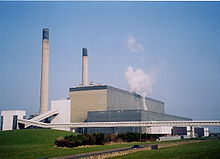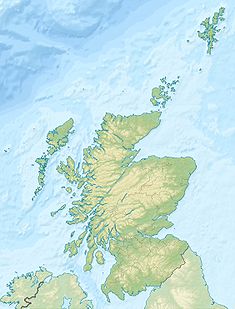- Cockenzie power station
-
Cockenzie power station 
Cockenzie Power Station
Viewed from the south in March 2003Location of Cockenzie power station Country Scotland Location Cockenzie Coordinates 55°58′06″N 2°58′18″W / 55.968263°N 2.971544°WCoordinates: 55°58′06″N 2°58′18″W / 55.968263°N 2.971544°W Status Operational Commission date 1967 Operator(s) South of Scotland Electricity Board
(1967-1991)
Scottish Power
(1991-present)Power station information Primary fuel Coal Secondary fuel Biomass Power generation information Installed capacity 1,200 MW Website
www.cockenziepowerstation.comgrid reference NT394754 Cockenzie power station is a coal-fired power station in East Lothian, Scotland, capable of co-firing biomass. It is situated on the south shore of the Firth of Forth, near the town of Cockenzie and Port Seton, 8 mi (13 km) east of the Scottish capital of Edinburgh.[1] The station has dominated the local coastline with its distinctive twin chimneys, since it opened in 1967. Initially operated by the nationalised South of Scotland Electricity Board, it has been operated by Scottish Power since the privatisation of the industry in 1991. In 2005 a WWF report named Cockenzie as the UK's least carbon-efficient power station, in terms of carbon dioxide released per unit of energy generated.[2] The 1,200 megawatt power station is set to close by 2016, but there are plans to replace the current station with a Combined Cycle Gas Turbine (CCGT) power station.
Contents
History
Under a design by the firm of celebrated architect Sir Robert Matthew, construction of Cockenzie power station began in 1959 on the site of the former Preston Links Colliery. The site is also thought to have been the hiding place of General John Cope after the defeat of his army at the Battle of Prestonpans on 21 September 1745.[1] Much of the electrical equipment for the station was manufactured by Bruce Peebles & Co., Edinburgh. The station began generating electricity in 1968 for the then South of Scotland Electricity Board (SSEB). In the year 2000-01, Cockenzie generated a record load factor, supplying 3,563 GWh of electricity and burning 1,500,000 tonnes of coal.[1]
Specification
The power station occupies a 24 hectare site. It generates electricity using four 300 megawatt (MW) generating units, for a peak supply of 1200 MW.[1]
Operations
Coal transportation
Coal was originally supplied to the station directly from the deep mines of the neighbouring Lothian coalfield, but these have since been exhausted or closed. Subsequently coal has been supplied from open cast mines in the Lothians, Fife, Ayrshire and Lanarkshire.
The power station was the first to use the new "merry-go-round" system of coal deliveries by rail.[3] This system uses hopper wagons which carry around 914 tonnes of coal each. This coal is delivered to the station's coal store, which has the capacity to hold up to 900,000 tonnes of coal.[1] The coal store is situated on the opposite side of B1348 road between Prestonpans and Cockenzie and Port Seton, to the rest of the station. Coal is transported from the coal store to the station's boiler house by a conveyor belt. It is then weighed, sampled and screened, before being pulverised in a pulverising mill. It is then blasted into the station's furnaces with preheated air, to heat the station's boilers.[1]
Water use
The water used in the station's boilers is taken from the local water supply, but is purified in the station's water treatment plant. In the boilers, the water is super heated to a temperature of 556 °C, before it is piped to the station's turbogenerators. It hits the turbine blades, causing the turbine shaft to rotate at 3,000 rmp. This is connected to a generator, which generates electricity at 17 kilovolt (kV). The steam is reheated and then fed to intermediate and low pressure turbines.
After use, the steam is then condensed back into water, using a cooling medium; water from the Firth of Forth. Template:Convert/eimpSgal of water are used for cooling purposes every hour. It is then discharged back into the Firth of Forth.[1]
Ash use and removal
The burning of coal in power stations generates a lot of ash and dust. The station's electrostatic precipitators capture fly ash from the flue gases, preventing them from entering the atmosphere. Bottom ash is also produced by the station. Ash from the station is sold through the ScotAsh company, a joint venture between Scottish Power and Blue Circle. It is used in the construcion industry and in products such as grout and cement. Any remaining ash is piped to the large lagoons in the nearby town of Musselburgh, where it is capped and planted, and used as a nature reserve.[1]
Electricity distribution
The electricity is initially generated at 17 kV. This is stepped up via a transformer to 275 kV for distribution on the National Grid. The electricity is not just distributed to Scotland, but England too, which it is connected to via a double circuit overhead line, operating at 275 kV and 400 kV, to Stella near Newcastle upon Tyne.[1]
Post-privatisation and future
Since 1991, the station has been owned by the privatised Scottish Power utility group. It recently surpassed its originally intended lifespan. It is now run as a 'marginal station', guaranteeing seasonal and peak supply and non-availability of other power stations. For this reason considerable investment has been made to improve start-up times to maximise generating opportunities in the deregulated electricity generation market. Since 2001, the station has exported electricity to Northern Ireland via an undersea power link.[1]
CCGT replacement
The station must close by 31 December 2015, so Scottish Power are currently considering replacing it with a Combined Cycle Gas Turbine (CCGT) power station. If the station is built, it will require a 17 km (11 mi) gas pipeline from East Fortune, to supply it with fuel.[4]
References
- ^ a b c d e f g h i j "Cockenzie Power Station" (PDF). Scottish Power. http://www.scottishpower.com/uploads/CockenziePowerStation.pdf. Retrieved 6 February 2011.
- ^ Stevens, Charlie (13 July 2005). "Hazelwood tops international list of dirty power stations". WWF. http://www.wwf.org.au/news/n223/. Retrieved 6 February 2011.
- ^ Railway Magazine, March 1965 p172
- ^ "Overview". Scottish Power. http://www.cockenziepowerstation.com/. Retrieved 2 October 2009.
External links
- YouTube - Lighting of the Chimneys during the Three Harbour Arts Festival
- YouTube - Steeplejacks on the station's chimneys in July 1997
Energy in Scotland Energy in the United Kingdom Sectors Companies and
organisationsAquamarine Power · British Energy · EDF Energy · European Marine Energy Centre · FREDS · Community Energy Scotland · National Grid · Office for Nuclear Regulation · Pelamis Wave Power · Score Group plc · Scotia Gas Networks · Scottish Government (Energy Department) · Scottish Gas · · Scottish Hydro Electric · Scottish Nuclear · Scottish Power · South of Scotland Electricity Board · SSE · Wavegen · Wood GroupActive power stations CoalCockenzie · LongannetHydro-electricNorthern scheme · Ben Cruachan scheme · Breadalbane · Tummel · Foyers scheme · Sloy-Awe scheme · Galloway scheme · Glendoe Scheme · Lanark scheme · Kinlochewe-Talladale schemeNuclearOil and gasPeterhead · LerwickWaveIslay LIMPET · Siadar Wave Energy ProjectWindOtherDundee Incinerator · Greengairs · Lerwick Incinerator · Steven's Croft · WestfieldDecommissioned
power stationsCoalNuclearOil and gasInverkip (1988) · Fife (2011)See also  Category ·
Category ·  CommonsCategories:
CommonsCategories:- Buildings and structures in East Lothian
- Biofuel power stations in Scotland
- Coal-fired power stations in Scotland
- 1967 establishments in the United Kingdom
Wikimedia Foundation. 2010.


